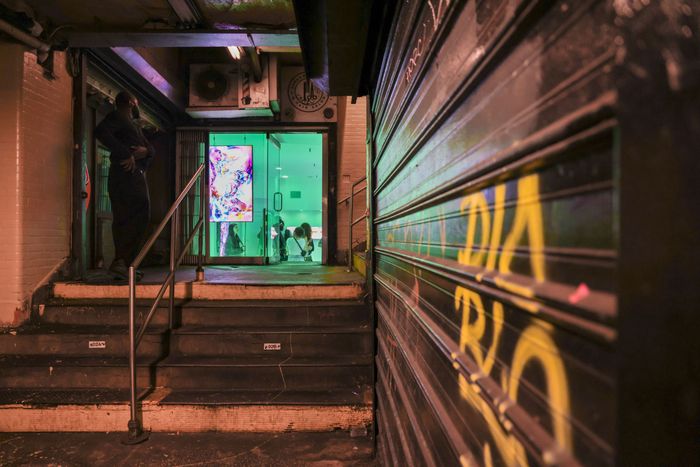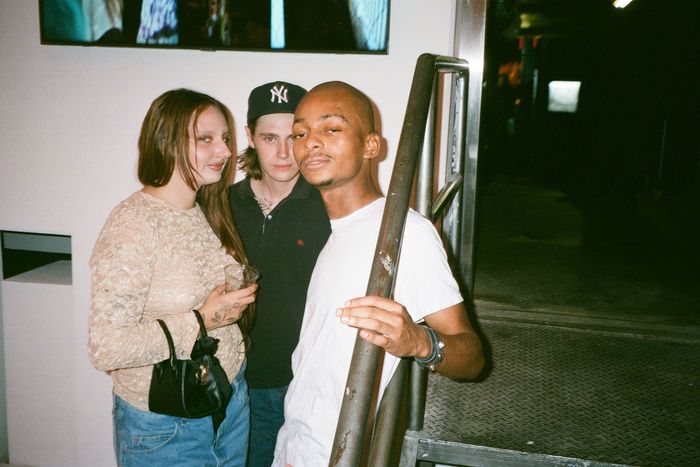
It’s Friday night, and I’m lost. For the past ten minutes, I’ve been wandering around the 50th Street 1 train station. “Do you know where the gallery is?” I ask one man in a blazer and chinos. He shakes his head without taking out his earbuds. After a few more minutes, I give up, walk back outside, and go down another entrance across the street. At the foot of the stairs, to my right, I see a small white room behind glass doors. Two people stand inside surrounded by large fuzzy screens. They open the door, and eerie ambient noise coming from the room thrums in the subway’s concrete stairwell. The people, Sam Black and Alison Sirico — the co-founder of Renegade Raves and a self-described “half-curator, half–crypto bro,” respectively — welcome me in: “You find us okay?”
The room, a pantry-size space at the bottom of the subway stairwell on 50th Street, is Public Works Administration, a digital-art gallery founded by Black and Sirico. Tonight, its stark-white walls are soaked in pinkish-yellow light for Kiernan “Knives” Francis’s solo show “Trade Winds, White Heat.” Since PWA opened its doors in May, Black and Sirico have curated three other exhibitions — two group shows and another solo show — centered on new media, a catchall term encompassing anything from digital illustrations to 3-D printed sculptures. Often, they sell some of the works as NFTs. She and Black work with local DJs to transform the space into more of an immersive experience. Tonight’s producer, Lucien Mount, is responsible, along with Francis himself, for the echoey synth leaking into the subway’s stairway. “Obviously,” says Black, “a subway station in Times Square doesn’t immediately register as, like, a cool place.” But with the right crowd on the right night, they wager, maybe it could be. Incidentally, it’s not the first time people have attempted to make this particular subway station a thing: From 1996 to 2007, the space was home to the dive bar Siberia, run by former Studio 54 bodyguard Tracy Westmoreland. (Anthony Bourdain was a regular, as was Michael Imperioli.) After that closed, it had a brief stint as a barbershop.
Tonight’s right crowd trickles in around 8 p.m. They wear puffy black UGGs and lacy white slip dresses and glittery press-on nails and kohl-black eyeliner and paint-stained overalls and checkerboard Vans. They’re artists and crypto evangelists and Pratt students and, unbelievably, one “van lifer” I interviewed a month ago. The first person I talk to, Nick Montfort, a poet and MIT professor, tells me about a series of computer-generated novels he’s recently developed. He describes one as composed of “headlinelike sentences” and another as a “conflation of texts about gun violence in the United States, drawing on the Wikipedias from different events.” He also tells me he’s attended all three of PWA’s other events. “It’s one of three commercial galleries in Manhattan with a heavy focus on digital art,” he says, “so I try to see the work at all of these, particularly if I don’t know the artists yet.”
On the walls are seven screens, a series of looping videos produced by Francis, a 21-year-old digital artist and Pratt student. The works exist somewhere between Ryan Trecartin and Richard Linklater. One shows a boy’s bare torso, his boxers just visible above his gym shorts. Another moves around a 3-D photograph of a group of people reaching for the same joint. The program informs me that Francis’s work “represents the repetitive grind of going out every night looking for the thing, person, or experience that makes us feel whole.”
Black organized a reception for the show at Nothing Really Matters, a bar owned by Adrien Gallo (who also ran the Lower East Side bars Double Happiness and Palais Royale) conveniently located a few feet away in the station. For years, the bar space was used as a storage area for Duane Reade, which sits right above it. Gallo moved in a few years before PWA did, installing custom blackout curtains in the windows facing the subway corridor and a disco ball in the corner. Throughout the night, attendees amble back and forth between the gallery and the bar. Every so often, a commuter cautiously steps inside one or the other, ogling. “Wait,” I overhear a man say, standing at the gallery’s entrance, backpack slung over his shoulder. “Is this, like, an MTA office?”
The gallery’s elusiveness, of course, is part of the whole appeal. “Nothing’s truly underground anymore,” Francis, the artist, says to me. “So now people are just trying to find untraditional exhibition spaces because it’s just more interesting and draws a better crowd.”
Sirico says she now sees Times Square as a proper burgeoning scene. “It was so uncool that now it’s kind of ironically cool,” she tells me. Beyond PWA and Nothing Really Matters, the nightclub Rash, whose Bushwick location was burned down in June, has been doing pop-up concerts every Tuesday a few blocks away at the Times Square Alliance, a corporate office on 46th and Broadway. But it might even go beyond Times Square, says Black. “Brooklyn’s been such a thing for so long, that now” — Sirico finishes, “Manhattan is coming back.”






